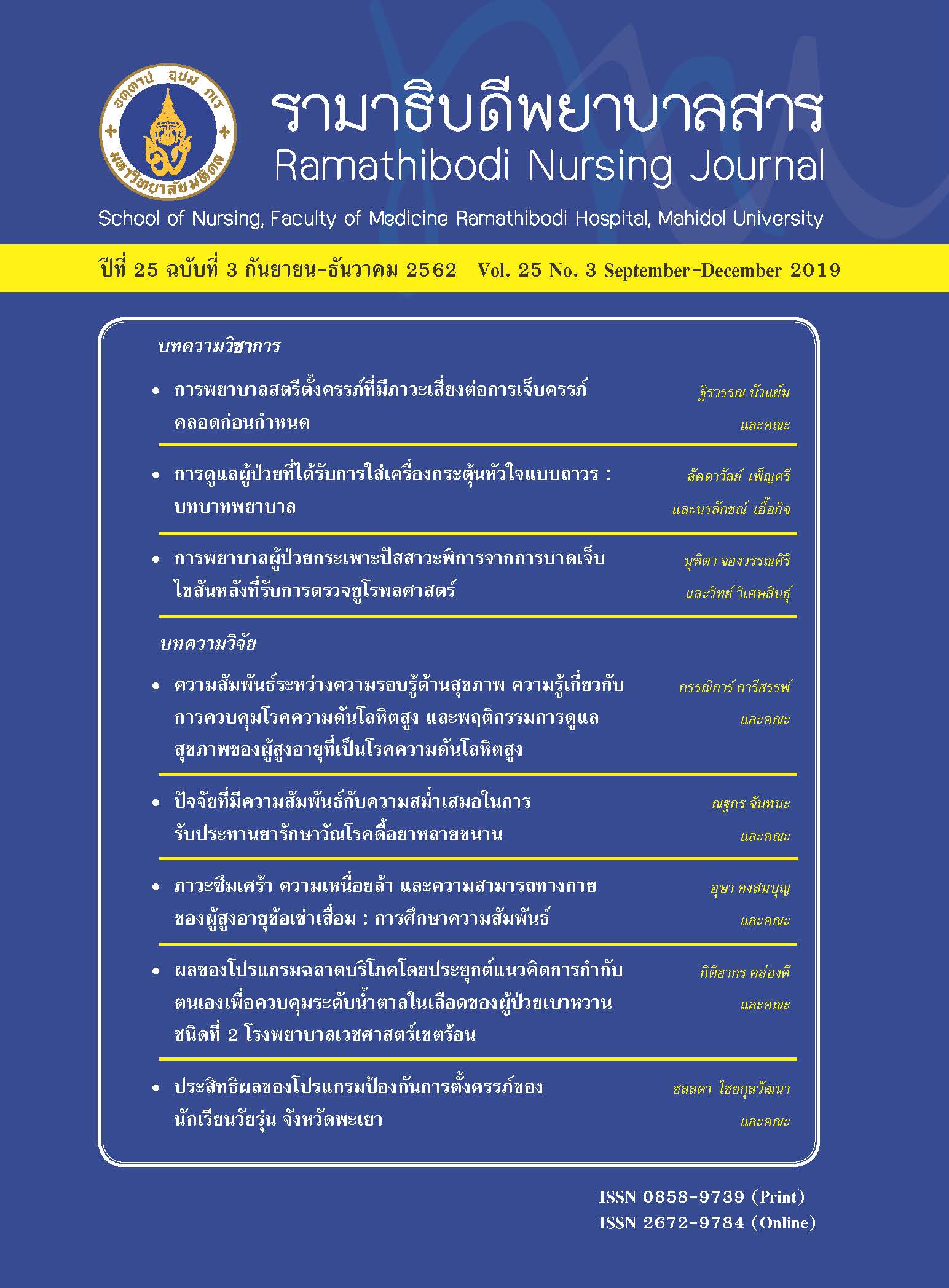Care of Patients with Permanent Cardiac Pacemaker: Nurse's Roles
Main Article Content
Abstract
Abstract
Cardiac permanent pacemaker is a device inserted to patients who have a problem of severe bradyarrhythmia. This device prevents patients with severe bradyarrhythmia from cardiac dysfunction and helps the function of the heart work properly. However, the patient needs to use this device all his/her lifetime. This leads the patient with cardiac permanent pacemaker need to adapt his/her health behavior to live appropriately. Nevertheless, it has been found that a number of patients still have had improper health behavior, leading negative consequences to their lives. Nurses have important roles to help promote health behavior for these patients. Providing helpful information to the patient with cardiac permanent pacemaker from admission to discharge to home will help maintain proper health behavior in the patient in order to have good health status and quality of life.
Article Details
บทความ ข้อมูล เนื้อหา รูปภาพ ฯลฯ ที่ได้รับการตีพิมพ์ในรามาธิบดีพยาบาลสาร ถือเป็นลิขสิทธิ์ของวารสาร หากบุคคลหรือหน่วยงานใดต้องการนำทั้งหมดหรือส่วนหนึ่งส่วนใดไปเผยแพร่หรือเพื่อกระทำการใด ใด จะต้องได้รับอนุญาตเป็นลายลักษณ์อักษรจากรามาธิบดีพยาบาลสารก่อนเท่านั้น
References
(in Thai)
2. Asdornwises U. Management of clients with dysrhythmias. In: Srimoragot P, editor. Medical-Surgical nursing: clinical M. Bangkok: iGroup press; 2010. (in Thai)
3. Boonwisut W. Bradyarrhythmia. In: Krittayaphong R, Phankingthongkum R, Wongpraparut N, Maneesai A, editors. Cardiac emergencies. Nonthaburi: Pappim; 2016. (in Thai)
4. Saengern U. Bradyarrhythmias. In: Wattanaprasan P, editor. EKG interpretation and management for ICU nurse.
Bangkok: Chanmuang press; 2012. (in Thai)
5. Kurucova R, Ziakova K, Gurkova E, Simkova E. Quality of life of patients with a permanent pacemaker.
OPAJ.2013;5(1):15-20.
6. Mond HG, Irwin M, Ector H, Proclemer A. The world survey of cardiac pacing and cardioverter-defibrillators:
calendar year 2005 an International Cardiac Pacing and Electrophysiology Society (ICPES) project. Pace 2008;
31(1):1202-12.
7. Mond HG, Proclemer A. The 11th world survey of cardiac pacing and implantable cardioverter-defibrillators:
calendar year 2009–a World society of arrhythmia’s project. Pace 2011;34(1):1013–27.
8. Kasemsuwan P. Annual scientific meeting: The Thai cardiac EP club. Bangkok; 2016. (in Thai)
9. Thachinlert B. The development of self-efficacy program in patients with permanent pacemaker in Srinagarind
hospital.[dissertation]. Khon Kaen: Khon Kaen University;2008. (in Thai)
10. Lelakowski J, Podolec P. Quality of life in patients after implantation of pacemaker type DDD. Polski merkuriusz
lekarski. 2000;50(9):554-6.
11. Dirks JL, Waters JM. Cardiovascular therapeutic management. In: Urden LD, Stacy KM, Lough ME,editors. Priorities in critical care nursing. Canada: Elsevier Health Sciences; 2015.
12. Tantitum P. Nursing care for cardiac pacemaker patients. In: Hanucharurnkul S, editor. Medicine nursing. 16thed.
Bangkok: VJ Printing company; 2009. (in Thai)
13. The Heart Association of Thailand Under the Royal Patronage of H.M. The King Medical treatment for cardiac
arrhythmia and heart failure with electronic implanted 2552 [cited 2016 October 1st]. Available from: https://
www.thaiheart.org/images/column_1291454908/ DeviceGuideline.pdf (in Thai)
14. Malm D, Hallberg L. Patients’experiencesof daily living with a pacemaker a grounded theory study. J Health
Psychol. 2006;11(5):787-98.
15. Aqeel M, Shafquat A, Salahuddin N. Pacemaker patients’ perception of unsafe activities: a survey. BMC Cardiovasc
Disor. 2008;31(8):1-5.
16. Pongsuay C, Choowattanapakorn T. Experiences of older persons living with permanent pacemakers. J Nurs Sci
Chulalongkorn University. 2012;24(3):79-91.(in Thai)
17. Kotsakoul M, Kioumis I, Lazaridis G, Pitsiou G, Lampaki S, Papaiwannou A et al. Pacemaker insertion. ATM J.
2015;3(3):1-8.
18. Palmer SJ. Post-implantation pacemaker complication: the nurse’s role in management. Brit J Cardiac Nurs. 2014;
9(12):592-8.
19. Kanjanarutjawiwat W, Pitaksuteepong T, Dermsomboon R. Permanent pacemakers: Prapokklao hospital experience
complication and management. J Prapokklao Hospital Medical Education Center. 2015;32(1):58-67. (in Thai)
20. Sansaneewitayakul B. Pacemaker electrocardiography. In: Sutthisook S, editor. Textbook of electrocardiogram.
Bangkok: Vinterprint; 2002. (in Thai)
21. Schiariti M, Cacciola M, Puddu PE. Complications of pacemaker implantation. Research Gate. 2011;38(2): 271-98.
22. Totb P, Knecbt J. Pacemaker. LPN.2009;5(1): 40.
23. Arrhythmia Alliance. Pacemaker Patient Information 2014 [cited 2016 October 1].Available from: www.
heartrhythmalliance.org/resources/view/283/pdf
24. American Heart Association. Living with your permanent pacemaker 2014 [cited 2016 May 1]. Available from:
https://www.heart.org/HEARTORG/Conditions/ Arrhythmia/Prevention TreatmentofArrhythmia
25. Figueroa C, Alcocer L, Ramos B. Psychological intervention to modify anxiety, depression and quality of life in patients with an implantable pacemaker. Psychology. 2016;7(3)374-81.
26. Pensri L. The effect of education and social support program on health behaviors in patient with cardiac permanent pacemaker. Chulalongkorn university; 2017.
27. Cynthia M & et al. Description of a nursing intervention program after an implantable cardioverter defibrillator.
Heart & Lung. 2014;3(33):183-90.
28. Rajgopal S and et al. CSI/IHRS practice guidelines on follow-up of patients with permanent pacemakers A
Cardiology Society of India/Indian Heart Rhythm Society task force report on practice guidelines on follow-up of
patients with permanent pacemakers. Indian Heart Journal. 2012;64:12-7.


